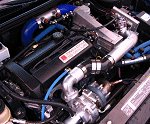

|
Street Class Unlimited Class
DOHC SOHC Ion Updated 1/05 For the most recent list of the fastest five cars click here. |
Turbocharging 101by: qksl2
So you wanna turbocharge your Saturn? Do you want to build your own turbo kit but have no idea where to start? Are you unsure of what turbo, what intercooler, or how to add fuel to your setup? Well, I have am working on putting together a DIY Turbo installation section. I will try to cover everything that is needed to safely and effectively turbocharge your Saturn. There is a huge demand for something like this, so I will try to be as helpful as possible. Please shoot all questions to webmaster@qksltwo.com. 1. What are your goals? How fast do you want to go? How much boost and what kind of driving do you want to do? If you want a quick street car for light to light racing, and extra punch all over, you'll want a low boost, small turbo setup. If you want a freeway terror, prepare to do a larger turbo along with more engine mods to handle the power output. First, make that decision. You'll always be compromising one aspect of performance for another. I'll write this with what I know best: a well balanced setup for the "average" enthusiast. This is assuming a driver who wants reasonable daily driveability, street quickness, and weekend warrior speed. 2. The motor. Is your motor ok to boost on? Should you build the internals before boosting at all? Mostly, this depends on how much boost you want to
run. Let me make this clear: it is entirely possible to run boost
for a long time on a stock motor in good condition. The key? Proper
tuning and smart driving. That means not getting greedy with boost,
and careful maintaining of the car. Changing plugs and oil often
is very important, minimally. You'll also want to make sure auxiliary
items are in good shape: Fuel injectors, 02 sensor, fuel pump, etc...
all need to be in good working order. As far as the motor, its best
not to boost on high mileage cars. High mileage does NOT automatically
mean the engine is in any worse condition, but it is more likely.
One way to test if your engine is in good condition is to compression
and leak down test it. Any shop can do it for you easily, or you
can buy the tools to do it yourself from your local parts store.
Compression should be between 180 and 210. Anything lower and your
engine may not be a good motor to put extra strain on. Keep in mind that stronger internals do not mean more power. They are simply a way to have a "buffer zone" against engine damage, should detonation occur. Detonation that will break stock pistons or rings will break forged internals as well.... its just a matter of time. That being said, stock internals are good for lots of power if tuned correctly. The pistons on the older engines have thicker ring lands which are more resistant to cracking. All of the engines stock have 9.5:1 compression. With a good fuel system, one can safely run 200whp in good tune. This is good for low fourteens easily... For daily driving, though, I highly recommend boosting down: while maybe not necessary, it reduces stress on the motor. Believe me... 3 psi is more than enough for tooling around. 3. The manifold: What style should I get? What kind of flange? A turbo manifold is just like your stock exhaust manifold
except for that it directs air into the turbo to drive the exhaust
wheel instead of leading straight out to the exhaust system. After
going through the turbo, the downpipe is what connects the turbo
to the rest of the exhaust. The design of this is critical. There
are log style turbo manifolds, cast, and tubular style. Tubular
equal length manifolds make the most horsepower, with longer runners
and an equal length design. They are designed to where exhaust pulses
do not interfere with each other. Faster spool up and strong top
end power are characteristic of this style. However, they are typically
more expensive, require more bracing to prevent any cracking. They
also take up more space and are more difficult to design. Both Garage
Advance and Turbosaturns.net are making equal length tubular manifolds.
Email me for details. Twistec has popularized the use of a stock cast exhaust
manifold that has the bottom chopped off and a flange welded on.
This design is efficient in packaging. The cast manifold is very
strong, and although tedious, when properly welded, the flange mounting
is good as well. This puts the turbo down low, which is generally
a good thing. The main drawbacks for this manifold is that horsepower
is limited by the extremely small stock runners. It is also not
equal length. However, it is cheap to build, and effective for a
low boost setup. Log style manifolds come in many variations. They
are available now from Turbosaturns.net as well as Garage Advance.
Thomas Knight has had a design, but I believe is no longer making
them. The Garage Advance design is a very typical and simple log
style. This has been used to make great power on a saturn, despite
its design. The benefits are that they are relatively cheap and
simple, as well as strong. The Turbosaturns.net log style is better
than most, with slightly longer runners and a reasonable collector.
As far as making your own, you'll have to work with a shop that does TIG welding. SS is the best way to go, and you can then have it ceramic coated. It is not necessary, but nice for looks and heat control. The best flange for most applications will be a standard T3 flange, as it allows you a variety of options. 4. What kind of turbo should I get? Ok, let me make this easy. For a stock saturn motor
looking for a great powerband, a T3 is the best way to go, period.
For specifics, you'll want a .60 compressor side and a .48 exhaust.
Right here, I won't go into the A/R's (Aspect Ratios) for simplicity
reasons. But a larger number will flow more CFM at a given RPM than
a smaller number. So a .48 exhaust ensures quick spool up, and a
.60 compressor will flow a lot of air for lots of hosepower. Lag
is the time that it takes for a turbo to get up to speed where it
produces boost. So the weight of the rotating wheels causes the
lag. A larger T4 compressor or exhaust wheel is heavier, and the
extra inertia takes it longer to get up to speed. The exhaust wheel
is 70% of the weight, so the size and trim has the most effect on
spool up. You can change the compressor wheel a lot more without
affecting spool up too much. That is why a conservative .48 exhaust
is good, while a larger .60 compressor is perfect. On a stock saturn
motor, this means boost in the 2000-3000rpm range, depending on
your setup. The midrange is stronger, with a nice surge of power.
Then you run right into a rip roarin' top end, a huge whack of power
will lay you into the redline very quickly. On the freeway, lag
as absolutely nonexistent: think about the go pedal and you're in
boost, pulling harder than any n/a saturn can downshifting to third,
while at 3000 rpm in fifth.... From a roll, it will break the tires
loose as the boost comes up. Its really quite amusing. 5. How do I add fuel to my turbo system? This is the most controversial issue out there, right
now. There are several methods that work, some proven, some not.
For Saturns, you can do a few things: Larger injectors with an rising
rate fuel pressure regulator (RRFPR), an AFC or AFR with larger
fuel injectors, extra injectors and a control unit, or a full stand
alone fuel system. A simple and effective way to add fuel for low boost would be to use larger injectors, such as 35# injectors along with a RRFPR. You'll need "Bosch" style injectors: commonly available as Ford or Mopar injectors. Check out www.fwdperformance.com for injectors. 35# injectors are good for a descent increase in power, along with a fuel pressure regulator that is either 1:1, 2:1, or maximum 3:1. This setup will be safe, consistent, and easy. It should be tuned on the dyno by adjusting base fuel pressure. BTW: A rising rate FPR bumps up fuel pressure as boost goes up. A 2:1 raises fuel pressure 2psi for every 1psi of boost. So at 5 psi of boost pressure, fuel pressure goes up 10 psi, which adds the extra fuel necessary for boost. This is not the most precise way, but it works, and should be reliable. It will DEFINETELY require tuning on a dyno, though! |
|




